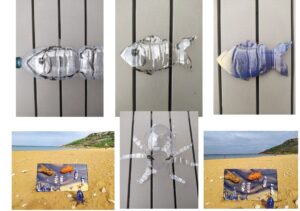BeMED 15. Creating a Collage from Plastic Waste to Reduce Plastics in the Marine Environment
Title |
Creating a Collage from Plastic Waste to Reduce Plastics in the Marine Environment |
Author |
Lino Xerri |
Age Guide |
Year 7 |
Subject Area |
Art |
| Preparation Time | Preparation of a large cardboard to support the collage with the students’ works. |
| Estimated Duration | 90 minutes |
| Site | If lesson is held out of class, the hot glue gun is to be portable and images of marine life are to be projected in a different way instead from an interactive board. |
| Educational objectives | Learning to express creatively one’s ideas
Learn how to fight against marine pollution by reusing Develop technical skills of plastic sculpture |
| Learning Outcomes | – I can investigate, observe and gather data information about my environment.
– I can demonstrate and discuss the developments in my work as I gain new techniques, skills and confidence with 2-Dimensional and 3-Dimensional media. – I can justify the importance of identifying problems, reflecting critically, thinking creatively and having a wider vision in order to plan for the future and become an effective agent of change. – I have a future-oriented perspective for how I live my life as a citizen of the world. |
| Link to SDGs | SDG 14: Life below water |
| Educational resources required | Plastic bottles, craft knife, permanent marker, hot glue gun, round-edged scissors, paint brushes, palettes, watercolour paints, interactive board.
Appendix 15.1 – Sea Creatures |
| Remote preparation | Students will research and document by producing sketches and photocopies of marine creatures. |
| Planning Considerations | Working with plastic as a medium requires the use of round-edged scissors and a craft knife. Teacher supervision must be constant and the student per teacher ratio must be adequate. |
| Method | Introduction
Discussion about the importance of keeping the sea clean, especially closed basins like the Mediterranean, is highlighted. The beauty of the sea that surrounds our islands and about the creatures that live in it must be a positive keynote to mention. The teacher shows images of sea creatures (Appendix 15.1) and helps students observe the shapes, lines and colours perceived in the images. Teacher gives a demonstration on how to draw a fish on a plastic bottle using a permanent marker and how to cut it out. Development Students are grouped in teams so that although they work on an individual piece, peer suggestions and help are still considered. They use a permanent marker to draw fish, seahorses, shells, seaweed and other marine creatures on plastic bottles and other plastic items they have brought with them. Using scissoring skills and with the help of the teacher, they cut out the figures they drew using a rounded-edge scissors and craft knife. Students paint the back of the plastic figures using bright watercolours to obtain a translucent effect. They are instructed to observe the shapes, lines and colours of the marine creatures they have researched and documented beforehand in the remote preparation for this lesson. Students affix the figures using hot glue on a pre-prepared cardboard in order that all the student’s creations are displayed as a large collective collage of an underwater scene. Conclusion Students are induced into thinking of other ways of exhibiting their works. The possibility of a mural or a mobile is elicited. Students are encouraged to suggest other projects that can be created using plastic waste and other waste materials instead throwing them away with the possibility of marine pollution. Ideally all plastic waste is recycled. |
| Follow-up activities | Students are encouraged to share with their friends their experiences during this activity. Here photographs taken by the students themselves might become useful. This can be done also through social media which is a medium that the students are comfortable at using.
Note: Unfortunately the end product may not be recyclable any more. Try to think up ways how the end result can be fully recyclable. It is important to consider the number of plastic bottles used to do this lesson and to compensate it is suggested that student do a clean up in a valley or other location where they will save other plastic bottles (amongst other ways) from polluting the environment. |
| Background information for educators | These images are suggestions of work processes and final works. Educators are to choose according to the students’ needs if they want to show these images to students before, during, or at the end of the activity, or if to be used at all.
Suggested links: http://www.noaa.gov/education/resource-collections/ocean-coasts/ocean-pollution |
| Adaptations | The lesson plan has the aim of having every student produce an individual final piece as a result of his work, however group work is still considered and particular students having difficulties at some point, can still manage by working in a group and share in the production phase. |
| Extensions | Students who are more technologically able can produce a video clip of the activity, underlining its educational objectives.
Those students who like reporting can forward a small report of the activity to the press, school newspaper and website. |




